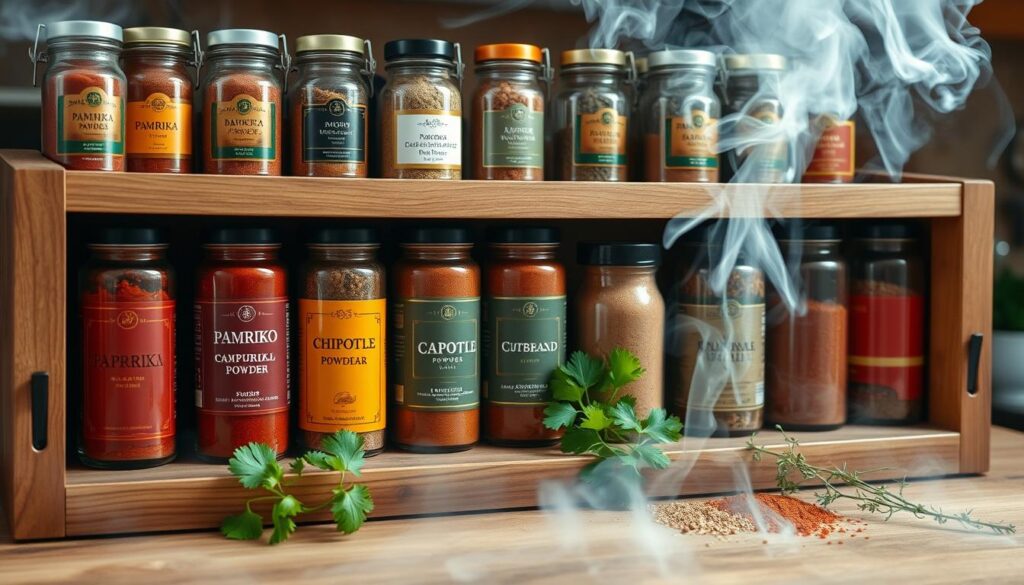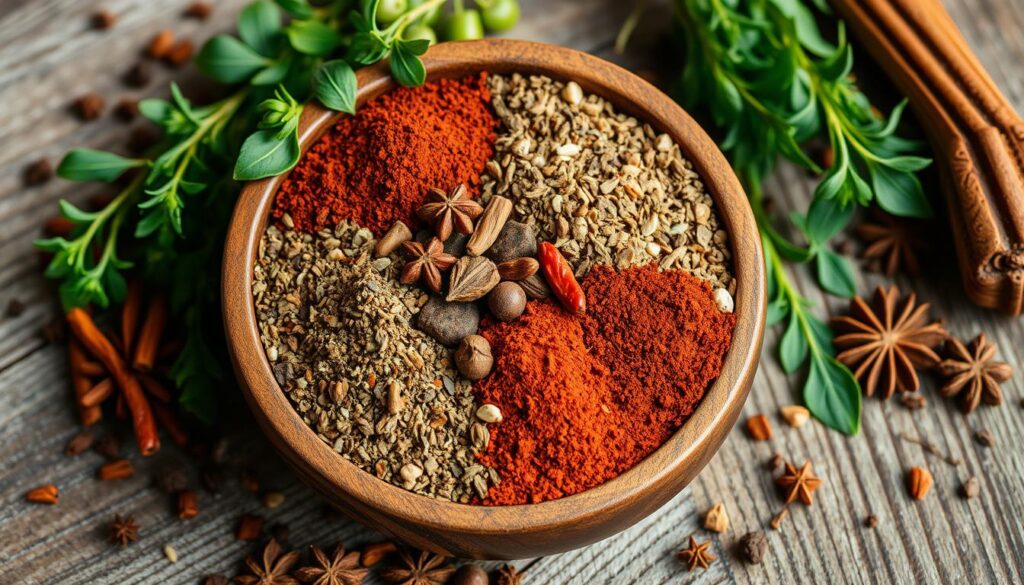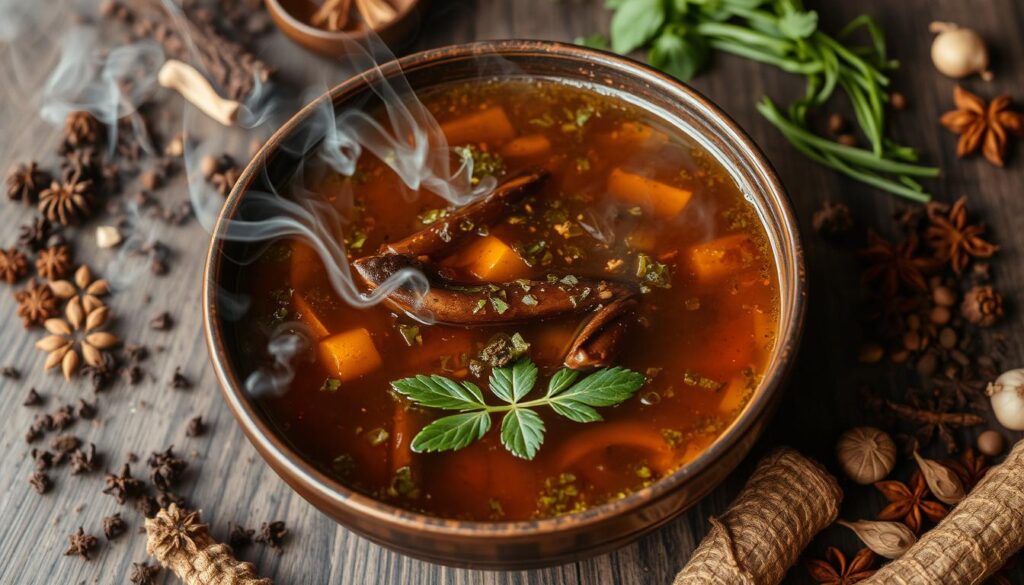Table of Contents
Liquid smoke was first used in 1895 by Ernest H. Wright. It’s a way to add smoky taste to food without a smoker or grill. Sometimes, we look for other options due to diet, availability, or taste. Luckily, there are many natural and flexible substitutes that mimic liquid smoke’s smoky flavor.
Key Takeaways
- Liquid smoke was first introduced in 1895 by Ernest H. Wright, a Kansas City pharmacist.
- Liquid smoke is a vegan product that does not contain any animal products.
- Popular liquid smoke substitute options include smoked paprika, chipotle powder, and smoked salt.
- Smoked paprika and chipotle powder can be used in a variety of dishes, from BBQ sauces to vegan recipes.
- Substitutes can offer authentic smoky flavors without the need for a grill or smoker.
Understanding Liquid Smoke and Its Uses
Liquid smoke is a flavoring that makes food taste like it’s been smoked, without the smoke. It’s made by burning wood chips and catching the smoke in a liquid form. This liquid captures the flavors and smells of the smoke.
What is Liquid Smoke?
Liquid smoke is a food additive that adds a smoky taste to dishes. It’s made by collecting smoke from burning wood, cooling it, and then bottling it. This way, it keeps the smoky flavor that’s lost in regular smoking.
How is Liquid Smoke Made?
To make liquid smoke, wood chips are burned in a special chamber. The smoke is then cooled and collected as a liquid. This liquid is what we bottle as liquid smoke.
Common Culinary Uses of Liquid Smoke
- Flavoring meats, poultry, and seafood
- Enhancing the taste of vegetables, legumes, and grains
- Adding a smoky note to sauces, marinades, and dressings
- Infusing cocktails and desserts with a unique, smoky profile
- Mimicking the flavor of bacon in vegetarian and vegan dishes
Liquid smoke is great for adding smoky flavor to many dishes. It’s easy to use and doesn’t require special equipment or long smoking times.
Why We Might Need Substitutes
Liquid smoke is easy to find in most grocery stores in the U.S. But, there are good reasons to look for liquid smoke alternatives. These include health-conscious options and meeting dietary restrictions. They give us more choices in the kitchen.
Health Considerations
Some people worry about the health risks of liquid smoke. It might contain PAHs, which could increase cancer risk. Those looking for safer choices might try natural smoking or other ingredients that taste similar but are healthier.
Dietary Restrictions
For vegans, vegetarians, or those on Paleo or Whole30 diets, liquid smoke is not an option. It’s not animal-friendly or processed enough. Liquid smoke alternatives let these folks enjoy smoky tastes without breaking their diet rules.
Availability Issues
Sometimes, liquid smoke is hard to find, especially in certain areas or when it’s in high demand. This scarcity leads people to seek liquid smoke substitutes. Having different options ensures our dishes stay smoky, even when liquid smoke is out of stock.
The drive for liquid smoke alternatives comes from health worries, dietary needs, and supply problems. By exploring these options, we can make tasty, health-conscious meals and stay creative in the kitchen.
Choosing the Right Substitute
When picking a liquid smoke substitute, think about the dish’s flavor and how smoky you want it. Different options have different smokiness levels and might add spices or sweetness. It’s key to match the substitute with the dish for the best taste.
Flavor Profiles to Consider
Liquid smoke adds smokiness to foods like meat and veggies without smoking them. But, it has harmful PAHs, so we look for safer alternatives. Looking at the flavors of different substitutes helps find the perfect one for your dishes.
- Smoked Paprika: Made by smoking and drying peppers, it gives a deep smoky taste.
- Chipotle Powder: Used in Mexican food, it’s made from smoked jalapenos, adding a smoky kick.
- Smoked Salt: Smoked over wood, it adds smoky flavors like hickory or applewood.
- Smoked Tea: A Chinese black tea smoked to give a smoky taste without bitterness, great for brines or rubs.
Compatibility with Different Dishes
Choosing a substitute needs to match the dish. Start with a little and adjust to get the right smokiness. This ensures the smokiness works well with the dish’s other flavors.
| Substitute | Recommended Substitution Ratio | Best Dish Pairings |
|---|---|---|
| Smoked Salt | Use about half the amount of smoked salt for the recommended liquid smoke | Grilled meats, roasted vegetables, soups, and stews |
| Chipotle Powder | Use about half the amount of powder for the recommended liquid smoke | Mexican-inspired dishes, barbecue rubs, and marinades |
| Smoked Paprika | Start with about half a teaspoon for every teaspoon of liquid smoke | Roasted vegetables, stews, and meat dishes |
| Smoked Tea | Add a few teaspoons of the strong infusion to the recipe, adjusting to taste | Brines, marinades, and sauces |
By looking at flavor and dish compatibility, you can pick the best liquid smoke substitute. This will enhance the smokiness in your cooking.
Common Liquid Smoke Substitutes
Liquid smoke adds a smoky flavor to dishes. But, there are natural alternatives that work just as well. Let’s look at smoked paprika, chipotle powder, and hickory smoked sea salt as common substitutes.
Smoked Paprika
Smoked paprika is made from red peppers smoked over wood. It has a smoky taste that’s more intense than regular paprika. It’s great in meats, stews, roasted veggies, and dips.
Chipotle Powder
Chipotle powder is made from smoked jalapeños. It’s spicier and smokier than liquid smoke. It’s perfect for Mexican dishes, adding depth to sauces and marinades. Start with a little, as it’s quite strong.
Hickory Smoked Sea Salt
Hickory smoked sea salt is a simple but effective substitute. It’s smoked sea salt over hickory wood. It adds a smoky flavor to grilled meats, veggies, and baked goods. Use it during cooking or as a finishing salt.
These three – smoked paprika, chipotle powder, and hickory smoked sea salt – are easy to find. They’re versatile and can give your dishes a smoky flavor without liquid smoke.

“Smoking food brings a new level of deliciousness, with smoked meats or cheese providing an alternative to liquid smoke.”
Homemade Liquid Smoke Alternatives
Creating smoky flavors in our dishes doesn’t always mean buying liquid smoke. There are many homemade options that offer natural and customizable smokiness. Let’s look at some DIY alternatives for the perfect homemade smoke flavor.
DIY Smoked Spice Blend
One easy way to add smoky notes is by making a homemade smoked spice blend. Burn a few slices of bread until charred, then grind them into powder. Mix this smoked bread powder with spices like paprika, garlic powder, and onion powder. This blend can add depth to rubs, marinades, and roasted veggies.
Infused Oils for Smoky Flavor
Making our own infused oils is another smart way to add DIY smoky seasoning to our cooking. Heat wood chips or charcoal briquettes, then let the smoke infuse a neutral oil like olive or vegetable oil. Use this smoky oil to sauté, drizzle, or baste dishes. It’s perfect for grilled meats and roasted potatoes.
“Experimenting with different combinations of liquid smoke substitutes, such as smoked salt or smoked tea, can help achieve the desired balance of smokiness, heat, and flavor according to personal taste preferences.”
Exploring homemade liquid smoke alternatives lets us control the smokiness in our cooking. Whether it’s a DIY spice blend or infused oils, the options for adding homemade smoke flavor to our dishes are endless.
Using Herbs and Spices as Substitutes
Herbs and spices can be great alternatives to liquid smoke. They add a smoky flavor to our food. This is without the health worries or finding issues that come with liquid smoke.
Liquid Smoke Alternatives in Rubs
Smoky herb blends and spice rubs can mimic liquid smoke’s taste. Mix smoked paprika, cumin, and herbs like thyme, rosemary, or oregano. This creates a strong, earthy rub for meats, veggies, and tofu.
Flavorful Marinades with Herbs
Marinades with smoked salt, fresh herbs, and vinegar or citrus juice add smoky flavor. The mix of smokiness, herbs, and tanginess can make simple foods taste amazing.
Herbs and spices let us explore smoky flavors without just using liquid smoke. These natural options add depth and variety to our cooking.
| Ingredient | Substitution Ratio | Suggested Uses |
|---|---|---|
| Smoked Paprika | 1/2 tsp for 1 tsp Liquid Smoke | Barbecue, marinades, rubs |
| Chipotle Powder | 1/4 – 1/2 tsp for 1 tsp Liquid Smoke | Chili, stews, soups, marinades |
| Smoked Salt | 1 tsp for 1 tsp Liquid Smoke | Seasoning meats, vegetables, soups |

“Herbs and spices can transform our dishes, imparting a smoky depth of flavor that rivals the impact of liquid smoke.”
Exploring Vinegar-Based Options
Vinegar offers a tangy and versatile alternative to liquid smoke. Apple cider vinegar and balsamic vinegar are two great options. They can add a smoky flavor to your dishes.
Apple Cider Vinegar for Smokiness
Reduced apple cider vinegar has a sweet and smoky taste. It’s perfect for substituting liquid smoke in many recipes. Its acidity and fruit notes enhance the smokiness, making it great for marinades and sauces.
Try simmering apple cider vinegar until it thickens. This will concentrate its smoky essence.
Balsamic Vinegar Variations
Aged balsamic vinegar adds a smoky dimension to your cooking. Its aging process creates complex, caramelized flavors. This can mimic the taste of liquid smoke.
Look for different balsamic vinegar types to find your favorite smoky flavor. Whether you pick apple cider or balsamic vinegar, they can add depth to your dishes. Use them in marinades, sauces, and dressings for a smoky twist.
Introducing Beer and Wine
Beer and wine can add a smoky depth to our cooking. Stout beers have rich, roasted malt flavors. They can replace liquid smoke. Full-bodied red wines add a subtle smoky complexity to dishes.
Stout Beer in Cooking
Stout beers, like porters and oatmeal stouts, have roasted, almost smoky beer flavors. These bold, malty brews add a wonderful depth to stews, marinades, and sauces. The caramelized malt notes pair well with heartier proteins and root vegetables.
Red Wine for Smoky Depth
Full-bodied red wines can add smoky nuance to dishes. Cabernet Sauvignon, Malbec, and Merlot are great choices. Their robust flavors and tannic structure add a subtle smoldering undertone to braised meats, stews, and sauces.
Using stout beer and rich red wines in cooking opens up a world of smoky beer flavors and red wine in cooking. It lets us explore flavors without just using liquid smoke.
“The key to unlocking the smoky potential of beer and wine lies in understanding their unique flavor profiles and how they can complement our favorite dishes.”
Incorporating Broths and Stocks
Broths and stocks can really change the game when adding smoky flavors to our dishes. By simmering veggies like roasted onions, garlic, and smoked paprika, we make a smoky vegetable broth. This broth is great for soups, stews, and sauces. For those who eat meat, simmering chicken bones with smoked salt and herbs makes a smoky chicken stock. This stock adds depth and complexity to many recipes.
Smoky Vegetable Broth
To make a smoky vegetable broth, start with root veggies like carrots, celery, onions, fennel, turnips, and potatoes. Roasting these veggies first enhances their sweetness and smokiness. Then, simmer them in water with smoked paprika. Adding ginger, herbs, sweet potatoes, mushrooms, broccoli, and kale boosts the flavor.
Even use veggie scraps like broccoli stalks, kale stems, and onion peels. They make a robust and umami-rich alternative to regular broths.
Chicken Stock for Smoky Flavor
For a non-vegetarian option, smoky chicken stock is perfect. Begin by simmering chicken bones, like those from pastured chickens, with smoked salt, apple cider vinegar, and herbs. The longer it simmers, the smokier it gets. This makes a rich base for soups, stews, and smoky broth recipes. Strain it well for a smooth texture.

“Homemade broth is healthier than store-bought options due to factors like flavor, sourcing of pasture-raised bones, quality control, and nutrition.”
Choosing between a smoky vegetable broth or a smoky chicken stock can take your dishes to new heights. These flavored stocks add smokiness and depth of flavor.
Utilizing Smoky Cheeses and Dairy
Adding smoky flavor to our dishes doesn’t mean we must use liquid smoke. Smoked cheeses like Gouda are great alternatives. They bring rich, complex flavors. Grated smoked cheese can be added to sauces, soups, or as a topping.
Another option is mixing cream cheese with smoky spices. This blend of cream cheese and smoked paprika or chipotle powder creates a creamy smoke substitutes. It adds flavor and texture to many dishes. This versatile spread or sauce can enhance dips, spreads, sauces, and marinades.
| Smoked Cheese Variety | Ideal Culinary Uses |
|---|---|
| Smoked Gouda | Grated into soups, sauces, or sprinkled on top of dishes |
| Smoked Cheddar | Incorporated into mac and cheese, grilled cheese sandwiches, or cheese plates |
| Smoked Mozzarella | Sliced and added to pizzas, salads, or caprese dishes |
| Smoked Provolone | Melted into hot sandwiches or used in cheese dips and spreads |
Exploring smoked cheese alternatives and creamy smoke substitutes can enhance our cooking. It lets us add a delicious smoky taste without just using liquid smoke.
The Role of Miso Paste
Miso paste is a great choice if you’re looking for a smoky flavor or umami-rich substitutes. This fermented soy-based condiment adds a complex, savory depth to dishes. It can mimic some of the qualities of smokiness.
Miso in Marinades
Adding miso paste to marinades gives a rich, umami-forward flavor. This enhances the overall taste of our meals. It works well with plant-based proteins, vegetables, or tofu, creating a smoky-inspired dish.
Enhancing Umami in Dishes
Miso paste is also great for boosting umami in recipes. Whisking it into sauces, dressings, or baked goods adds a satisfying savory quality. It’s a versatile umami-rich substitute for liquid smoke.

“Miso paste is a fermented food that offers a unique depth of flavor, and can be used to create a satisfying umami experience in plant-based dishes.”
Miso paste is perfect for mimicking smoky flavors or exploring new umami-rich possibilities. Its rich, savory profile can elevate many recipes. It’s a must-have for the modern plant-based cook.
Creative Cooking Techniques
Want to add real smoky flavor to your food without liquid smoke? We’ve got you covered! Grilling and using a smoker box with your gas grill are great ways to add natural smokiness.
Grilling for Natural Smokiness
Grilling over an open flame naturally adds smoky flavor to your food. For charcoal grills, throw wood chunks on the hot coals. This creates real smoke that fills your meats, veggies, and more.
The wood you choose, like oak, hickory, or mesquite, gives your food unique flavors. This makes your grilled dishes even more delicious.
Using a Smoker Box with Gas Grills
For gas grill users, a smoker box is a game-changer. These boxes hold wood chips or pellets. Place them on the grates or burners to create fragrant smoke.
As the box heats up, it adds authentic smoky notes to your food. This enhances your grilling experience.
Grilling and using smoker boxes let you enjoy natural smoke techniques without liquid smoke. Whether you’re grilling for flavor or using smoker box tips, these methods bring depth and complexity to your dishes.
Tips for Substituting in Recipes
Substituting liquid smoke in recipes needs care. Start with a small amount of your substitute and add more as needed. This way, you can control the smokiness and keep other flavors balanced.
Adjusting Quantities for Best Results
For smoked paprika, use half a teaspoon for every teaspoon of liquid smoke. Chipotle powder works well at a quarter teaspoon for each teaspoon of liquid smoke. Use Worcestershire or barbecue sauce in a one-to-one ratio with liquid smoke.
Tasting and Tweaking Flavor Profiles
It’s important to taste your dish while cooking. This lets you adjust the flavor to match the other ingredients. Keep adding or subtracting your substitute until the smokiness is just right.
| Liquid Smoke Substitute | Substitution Ratio |
|---|---|
| Smoked Paprika | 1/2 tsp per 1 tsp liquid smoke |
| Chipotle Powder | 1/4 tsp per 1 tsp liquid smoke |
| Worcestershire Sauce | 1:1 ratio with liquid smoke |
| Barbecue Sauce | 1 tbsp per 1 tsp liquid smoke |
| Hickory Seasoning | 1/2 tsp per 1 tsp liquid smoke |
The aim is to get that smoky taste without overpowering the dish. With some trial and error, you can make tasty recipes with that smoky flavor you love.
Storing and Using Substitutes
Keeping the smoky flavor of your homemade seasoning blends and infused liquids is crucial. Whether you’ve made a strong smoked paprika rub or a batch of smoked salt, the right storage can help. It keeps your substitutes fresh and flavorful for longer.
Shelf Life of Homemade Alternatives
Dry spice mixes like smoked paprika and chipotle powder can last up to six months. Store them in airtight containers in a cool, dark spot. This keeps their smoky flavor and color bright.
For homemade liquid smoke alternatives, refrigeration is a must. Use them within two weeks for the best taste. Infused oils with smoky notes can stay fresh in the fridge for about a month.
Best Practices for Storage
- Store dry spice blends in airtight jars or containers to prevent moisture and oxidation.
- Keep homemade liquid smoke substitutes refrigerated and consume within 2 weeks.
- Infused oils with smoky flavors should be stored in the fridge and used within 1 month.
- Avoid exposing your substitutes to direct sunlight, heat, or humidity, as these can degrade the smoke flavor preservation.
- Label all your homemade substitute storage tips with the preparation date to track freshness.
Proper handling and storage of your homemade seasoning shelf life is key. It ensures you enjoy the rich, complex flavors of your smoke-inspired creations for weeks. With a little care, your pantry will always have flavorful alternatives to liquid smoke.
Conclusion: Finding Our Perfect Smoky Flavor
The world of liquid smoke substitutes is full of options for adding smoky flavor to our food. From smoked paprika’s spiciness to miso paste’s earthy taste, each has its own special qualities. These alternatives can change how our dishes taste.
Summary of Key Substitutes
There’s a substitute for everyone, whether you like chipotle powder’s savory taste or hickory smoked sea salt’s woodiness. Infused oils are also great for adding smoky flavor. Trying these out lets us adjust the smokiness to fit our recipes perfectly.
Encouragement to Experiment in the Kitchen
Exploring different smoke flavors is all about having fun in the kitchen. By trying out various substitutes, we can make dishes that are truly our own. So, let’s get cooking and find the smoky flavor that we love the most.




